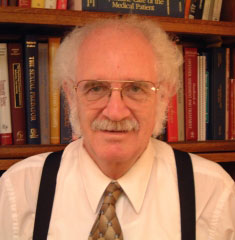One of our staff members is contributing considerably to a News Archiving service at Mu. Any well educated (Masters, PhD or above) users who wish to make comments on news sites, please contact Jim Burton directly rather than using this list, and we can work on maximising view count.
Gene Abel
Dr Gene G. Abel is a psychologist known for raising fear over pedophilia and child sexual abuse, mainly as an attempt to gain publicity for his Stop Child Molestation Book, Abel screening and behaviour-modification ventures. Abel conducts these campaigns through organisations that he set up - the Oakland-based Child Molestation Research and Prevention Institute and the Behavioral Medicine Institute of Atlanta.
In 1990, Abel was the recipient of the Society for Sex Therapy and Research Masters and Johnson award. It is unlikely that Abel would earn such an award in light of his activities since 1990.
Treatment of children
On his website,[1] Abel listed a number of behaviours that may be used to identify a child who is either "developing an inappropriate sexual interest in other, younger children" or a victim of molestation. These include:
- "Any child using sexual language beyond his or her age group."
- "Any child whom others report as having excessively sexually provocative behavior."
- "Any child who attempts to get another child or adult nude; especially at school or outside the home."
- "Any child who is overly attentive to younger children (three or more years younger)."
A child who exhibits any of these behaviours "needs an evaluation by a sex-specific therapist to determine the cause of the behavior." In his book, Abel explains that the therapist can then use the Abel screen, plethysmography, or a lie detector test to determine if the child is attracted to other children, and decide on a treatment regimen if so (covert sensitization, aversion therapy, SSRIs, etc.). There is no evidence for the efficacy of any of these treatments, particularly on juveniles.
Junk science

Abel is the source of many exaggerated statistics on child sexual abuse and pedophilia. He arrives at these figures through patently bad science. For instance, Marshall and Eccles (1991) pointed out that Abel, in concluding that sex offenders commonly have multiple paraphilias, had silently counted any offender reporting multiple deviant acts as more than one person, greatly inflating his findings.[2] While Abel's claim is at odds with most of the other literature, it was nonetheless accepted as gospel by the DSM.
Abel has also made the self-serving assertion that most child molesters are pedophiles, supposedly based on the results of "The Abel and Harlow Child Molestation Prevention Study." A vague description of this study can be found in his self-published Stop Child Molestation Book, but it has never been subject to peer review or published in a professional journal, nor is any real detail on its methodology available. In the study, any child molester whose behaviour persisted for a certain period of time was identified as a "pedophile," with no regard for their actual preferences.[3] The DSM diagnostic criteria for pedophilia were not meant to be interpreted in this way. Allen Frances, who chaired the DSM-IV Task Force,[4] writes:
Furthermore, criterion A was amended (by adding "behavior" along with "fantasies" and "urges") to emphasize that it is behavior that most typically brings individuals to clinical attention. [...] The revised criterion A wording has sometimes been used to justify making a paraphilia diagnosis based solely on a history of repeated acts of sexual violence, which is then argued as satisfying the statutory mandate for the presence of a "mental abnormality" (7, 8). This certainly was never our intent in DSM-IV. Defining paraphilia based on acts alone blurs the distinction between mental disorder and ordinary criminality.[5]
In another article, Michael First, editor of the DSM-IV text and criteria,[6] explains:
It had never been anticipated that any clinician would interpret the addition of “or behaviors” in Criterion A as indicating that the deviant behavior, in the absence of evidence of the presence of fantasies and urges causing the behavior, would justify a diagnosis of a paraphilia. The fact that some experts would use a literal interpretation of criterion A to justify making the paraphilia diagnosis based entirely on criminal sexual behavior goes against both the spirit of the DSM-IV and the requirements of the SVP commitment statutes in which the prior criminal sexual behavior alone is insufficient for finding that the offender is a sexually violent predator. The introduction to DSM IV-TR states clearly that “the specific diagnostic criteria included in DSM-IV are meant to serve as guidelines to be informed by clinical judgment and are not meant to be used in a cookbook fashion” (Ref. 5, p xxxii). The core construct of a paraphilia, which involves a deviant focus for sexual arousal, is the historical "sine qua non" of the diagnosis, and is so well established as to be irrefutable. The fact that a valid diagnosis of paraphilia cannot be made on the sole basis of criminal sexual behavior is clearly stated in the “Diagnostic Features” section for the paraphilias: “For Pedophilia, Voyeurism, Exhibitionism, and Frotteurism, the diagnosis is made if the person has acted "on these urges" or the "urges or sexual fantasies" cause marked distress or interpersonal difficulty” (emphasis added; Ref. 5, p 566). Were the criminal sexual behavior itself sufficient for making the diagnosis of paraphilia there would be no need for input from mental health professionals in making the diagnosis.[7]
The weight of other research contradicts the claim.
Commentary
A review of the Stop Child Molestation Book:
Abel recommends that all parents question their sons at around 6th grade about their sexual fantasies. Any boy who is suspected of having sexual thoughts involving younger children, or who has been sexually touched by an older child or adult, is to be referred to a "sex-specific therapist" who will test him for pedophilic symptoms. The test should be either a sexual interest test (developed by Abel himself, in which the boy examines photographs of children and adults in swimwear while a computer measures visual reaction time), a lie detector test, or a plethysmograph connected to his genitals while he looks at or listens to sexually stimulating material.
The problem with such tests (aside from their intensely humiliating and stigmatizing effects) is that they have never been validated, a process which would require testing a representative sample of American children to establish norms. In fact, all researchers are agreed that very little is known about normal sexual feelings during childhood and adolescence. To make matters worse, Abel refuses to release data necessary for independent researchers to evaluate his test.
However, the most chilling part of Abel's book comes when he outlines treatment methods to cure "pedophilia" among boys: separation from other children (possibly removal from the family), monitoring of sexual feelings and behavior by family members and friends who report to the therapist (and sometimes by plethysmograph), high doses of sex drive reducing drugs, covert sensitization, and aversion therapy with ammonia. The last two methods are intended to eliminate particular sexual thoughts by pairing them with pain, fear, or humiliation. Any of these methods may be imposed on the boy for life by the therapist, regardless of his or his parents' wishes.
Although Abel refers to them as "breakthroughs in testing, medicine, and therapies," students of history will recognize plethysmographs, sex drive reducing drugs, aversion therapy, and covert sensitization as the methods used decades ago to "cure" homosexuality. Mainstream health professionals and the public (even those who disapprove of homosexual behavior) now consider them ineffective, dangerous, and unethical. Numerous accounts show they lead to nightmares, depression, chronic anxiety, self-hatred, and suicidal thoughts among both gay men and children labeled as "deviant." And no wonder: considering the fact that we know almost nothing about the development of sexual feelings, it is clear that such efforts amount to messing with something we don't understand.
Like the "expert" doctors and therapists who justified their use on homosexuals, Abel shows no concern for emotional trauma and intense stigma these methods inflict on boys, instead rationalizing such abuse by writing that the protection of normal children takes precedence over the welfare of deviant children. Especially disturbing is the apparent endorsement of this approach by some other leaders in the juvenile sex offender industry-an approach that would create a new class of lepers consisting, presumably, of 5% of all boys.
References
- ↑ Archive: Sexually Troubled child
- ↑ Marshall, W. L., & Eccles, A. (1991). "Issues in clinical practice with sex offenders," Journal of Interpersonal Violence, 6, 69-70.
- ↑ Excerpts from The Stop Child Molestation Book.
- ↑ Frances, Allen (2009). A Warning Sign on the Road to DSM-V: Beware of Its Unintended Consequences, Psychiatric Times, 26 June.
- ↑ First, Michael B., and Frances, Allen (2008). "Issues for DSM-V: Unintended Consequences of Small Changes: The Case of Paraphilias," American Journal of Psychiatry, 165, 1240-1241.
- ↑ http://www.enotalone.com/authors.php?aid=1429
- ↑ First, Michael B., and Halon, Robert L. (2008). "Use of DSM Paraphilia Diagnoses in Sexually Violent Predator Commitment Cases," Journal of the American Academy of Psychiatry and the Law, 36(4), 443-454.
